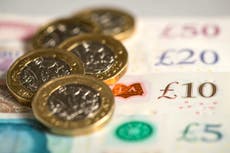Can government maintain confidence as the UK economy faces renewed surge of Covid-19?
The recovery was running out of steam before infections started to gather pace once more. Now ministers must raise their game, writes James Moore


This morning, Lloyds Banking Group publishes its UK sector tracker, which shows that in August a heartening 13 out of 14 recorded growth.
For the first time since February, tourism and recreation joined those in positive territory, with only transport still in a rut.
The findings are welcome, but even though the tracker also found that most of the UK’s domestic industries were outpacing their global and European benchmarks, there were signs of the recovery running out of steam. Other surveys have drawn the same conclusion.
We can expect September’s figures to register more of the same.
The chancellor’s successful “Eat Out to Help Out” scheme, funding discounted meals for people willing to eat out in the early part of the week, provided a shot in the arm to tourism and recreation in August. That has now ended, however, and the controversial closure of the job retention scheme is also in sight.
With areas of the northeast in a partial local lockdown, and the UK looking like it’s on a trajectory similar to that of France and Spain with respect to Covid-19, a backward step of some degree looks likely.
The question of how best to sustain the recovery is being usurped by the question of how best to contain the second wave of the virus at a time when many businesses are running on thin air as government support evaporates.
Looking at the northeast, the Centre for Economics and Business Research (CEBR) estimated that at its peak, the first lockdown cost the region £70m a day, or 34 per cent of gross value added.
The impact of the partial measures in force today, including the 10pm curfew and restrictions on meeting, will obviously be less. Having analysed the progress of the virus, the CEBR also thinks a return to a full lockdown could be avoided.
But the partial one will still be enough to tip over some businesses that might have survived in its absence.
This only serves to strengthen the case for more targeted government aid for hard-hit sectors and regions.
The CEBR fears that GDP might be as much as 3-5 per cent lower in the final quarter of this year when compared with the recovering third if two things happen: that people stop going out and the more general return to work that coincided with the reopening of schools is reversed.
It puts the cost of this to the economy at about £250m a day. That's only roughly a tenth of the impact of the lockdown at its peak in April. But it’s still a heavy blow and there is a potentially bigger cost that is much harder to quantify. If consumers, already fraying from the first lockdown, feel progress is going into reverse, their already wafer-thin confidence could end up squashed. And if consumers lose confidence, so will businesses. They’ll stop investing. They may choose to give up the ghost and fire people they had kept on furlough in the hopes of a pickup.
Maintaining confidence should therefore be a key priority for government. The challenge it faces in doing so shouldn’t be underestimated given the widely reported issues it has had with testing and other virus control measures.
A lack of confidence in government feeds through to a lack of confidence among consumers, which then feeds through to a lack of confidence among businesses, undermining the economy and undermining confidence in government. It is a circle that could quickly become very vicious indeed.
The coming winter is almost certainly going to go hand in hand with some level of economic chill, but there is still a window for the government to act to stave off the worst of it. The need for it to raise its game is rather urgent.



Join our commenting forum
Join thought-provoking conversations, follow other Independent readers and see their replies
Comments